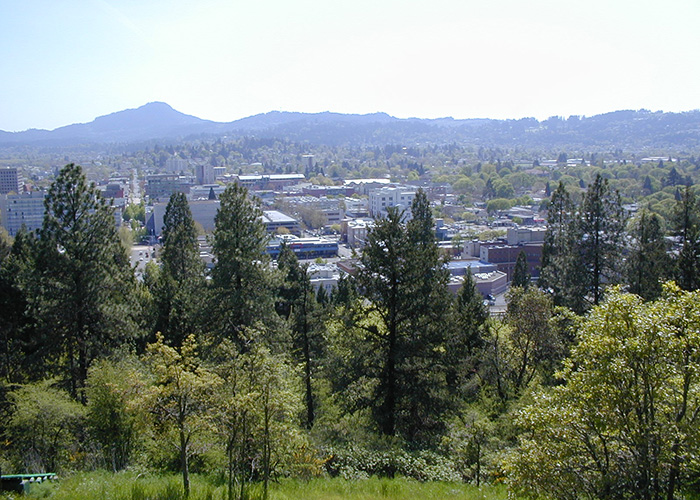 Comprehensive land use planning in Oregon is most well-known for its use of the "urban growth boundary" or UGB. The UGB is a used to contain urban development, but also as a tool to plan for orderly growth. Every incorporated city in the state has a UGB. The UGB is designated in the city's comprehensive plan. If land is inside a UGB, it is considered urbanizable. When designating an urban growth boundary, a city must plan to include a twenty year supply of land for housing, employment, industry, open space and recreational needs. A UGB should also provide plans for transition from urban to rural land uses, to avoid conflicts. Within a UGB, cities that are over 2,500 population will need to have or create a transportation system plan and public utility plan. And lastly, comprehensive plans should encourage efficient use of the land, to provide for more livable, walkable, and densely built communities.
Comprehensive land use planning in Oregon is most well-known for its use of the "urban growth boundary" or UGB. The UGB is a used to contain urban development, but also as a tool to plan for orderly growth. Every incorporated city in the state has a UGB. The UGB is designated in the city's comprehensive plan. If land is inside a UGB, it is considered urbanizable. When designating an urban growth boundary, a city must plan to include a twenty year supply of land for housing, employment, industry, open space and recreational needs. A UGB should also provide plans for transition from urban to rural land uses, to avoid conflicts. Within a UGB, cities that are over 2,500 population will need to have or create a transportation system plan and public utility plan. And lastly, comprehensive plans should encourage efficient use of the land, to provide for more livable, walkable, and densely built communities.
To write or update a comprehensive plan, there are many different pieces of information a local government takes into account. One critical element is a city's population forecast for the next twenty years, which can be provided by the Portland State University Population Research Center. This helps a city estimate how many new people are expected to locate in the city. The supply of "buildable lands" must also be recorded in an inventory. Among the buildable lands is land for housing. A city must perform a housing needs analysis, which demonstrates what types of housing, if any, are lacking in the current supply. An economic opportunities analysis helps a city determine whether or not there is need for additional employment or industrial lands, and what types of business development they could reasonably encourage or plan for. A city must also plan for adequate land for recreation and open space.
To locate an urban growth boundary, a city must complete a location analysis, comparing alternative locations and considering which addition to the UGB will result in the most accommodating and cost effective boundary, while creating the fewest conflicts with neighboring land uses, and causing the fewest negative environmental and economic consequences.
There are circumstances in which residential or industrial development may take place outside an urban growth boundary. Sometimes, this happens in the case of an unincorporated community. In other cases, it takes place in an "exception area", a lot or a parcel that was lawfully created and zoned prior to the beginning of the land use planning program.
Simplified UGB Expansion
Many local governments find the task of updating a comprehensive plan to be time consuming, complicated, and costly. Indeed, the elements of land use planning included in a comprehensive plan update can require expertise to execute well. To give local governments better access to the process of updating a comprehensive plan, in 2016 the Land Conservation and Development Commission adopted a
Simplified UGB Process. The simplified process reduces much of the complexity while encouraging cities to increase their development capacity and maintain a supply of land that is ready for development. Unlike the traditional UGB expansion process, which plans for a 20-year period, the simplified UGB process plans for a 14-year period.
Original Adoption: 12/27/74; Effective: 1/25/75
Amended: 9/5/80 (This amendment was invalidated by a court decision and thus did not remain in effect)
Amended: 2/17/88; Effective: 3/31/88
Amended: 10/28/94; Effective: 12/5/94
Amended: 9/28/00; Effective: 10/4/00—Application of Goal 14 to Lands Zoned for Rural Residential Use
Amended 4/28/05; Effective 6/28/05
Amended: 12/1/05; Effective 12/13/05
Amended 12/4/15; Effective 1/1/16
Read full text version of Goal 14
Administrative Rules that implement Goal 14:
OAR 660-011 – Public Facilities Planning
OAR 660-012 – Transportation Planning
OAR 660-014 – Newly Incorporated Cities, Annexations, Urban Development on Rural Lands
OAR 660-021 – Urban Reserves (applies statewide except the Portland Metro area)
OAR 660-022 – Unincorporated Communities
OAR 660-024 – Urban Growth Boundaries
OAR 660-025 – Periodic Review
OAR 660-027 – Urban and Rural Reserves in the Portland Metro Area
OAR 660-032 – Population Forecasts
OAR 660-038 – Simplified Urban Growth Boundary Method
Related:
 "Old" Goal 14
"Old" Goal 14
Population Forecasts
UGBs and Urban/Rural Reserves
Simplified UGB Calculator Tool
Transportation Planning Rule
Oregon Department of Transportation